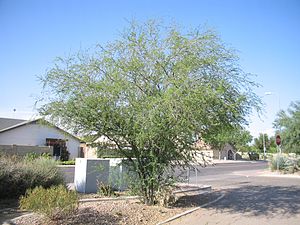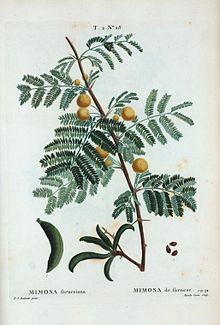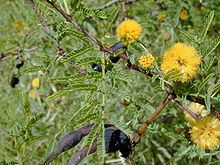Sweet acacia
| Sweet acacia | ||||||||||||
|---|---|---|---|---|---|---|---|---|---|---|---|---|

Sweet acacia ( Vachellia farnesiana ) |
||||||||||||
| Systematics | ||||||||||||
|
||||||||||||
| Scientific name | ||||||||||||
| Vachellia farnesiana | ||||||||||||
| ( L. ) Wight & Arn. |
The sweetness acacia ( Vachellia farnesiana ), also Cassia , Antilles acacia or sponge tree called, is a plant of the genus Vachellia in the subfamily of the mimosa plants (Mimosoideae) within the family of the Leguminosae (Fabaceae). It probably originates from the Neotropic , but is now found in all tropical regions of the world with a dry climate .
description
Appearance and leaf
The sweet acacia grows as a shrub or occasionally as a small tree and reaches heights of 2 to 3 meters. Their wood is hard, fine-pored and brownish-red to yellow. They are heavily branched. The bark of the branches is hairless or almost hairless. The stipules are transformed into 1 to 5 cm long thorns , which are quite conspicuous due to their white color. On the short petiole is a small gland. The small leaves are bipinnate. The two to six pairs of the first order Fiedern each consist of 10 to 25 pair pinna leaflet second order. The leaflets are 3 to 5 mm long and linear or linear-oblong with a blunt upper end. They are finely hairy or hairless, the main rib is almost in the middle.
Inflorescence and flower
In the leaf axils there are several clustered together, on slender, hairy and 2 to 4 cm long inflorescence shafts the dense, head-shaped inflorescences . The hermaphrodite, fragrant flowers measure about 1 cm in diameter and are yellow with a double flower envelope . The sepals are fused bell-shaped and 1.5 to 1.8 millimeters long. The crown is about 2.5 millimeters long.
Fruit and seeds
The two-chambered, dark rust-brown, hairless legume appears swollen and can be straight or curved. Their length is between 4 and 7 cm, the width is 1 cm and more. It is filled with a sweet “pulp”. The many seeds are in two rows in the fruit.
Chromosome number
The number of chromosomes is 2n = 26 or 52.
distribution
The sweet acacia is native to tropical America and grows there in the southern United States , Mexico , Guatemala , Belize as far as San Salvador and Panama , as well as on the West Indies and also in South America . In many parts of the Old World it is a neophyte .
Taxonomy
The first publication took place in 1753 under the name ( basonym ) Mimosa farnesiana by Carl von Linné in Species Plantarum 1, p. 521. The new combination to Vachellia farnesiana (L.) Wight & Arn. was published in 1834 by Robert Wight and George Arnott Walker Arnott was published in Prodromus Florae Peninsulae Indiae Orientalis , 1, p. 272. Other synonyms for Vachellia farnesiana (L.) Wight & Arn. are: Acacia farnesiana (L.) Willd. , Acacia minuta (MEJones) RMBeauch. , Acacia pinetorum F.J. Herm. , Acacia smallii Isely , Pithecellobium minutum M.E. Jones , Vachellia densiflora Alexander ex Small , Vachellia peninsularis Small .
use
The tannic fruits and the bark are often used as coloring agents; the fruits are often used to make ink. An adhesive can be made from the milky juice . In France, in particular, the trees are cultivated in order to use the flowers to produce a raw material for perfume production known as cassia.
literature
- Paul C. Standley, Julian A. Steyermark: Acacia. In: Flora of Guatemala , Fieldiana Botany, Volume 24, Part V, 1946. Pages 3-15.
- Acacia farnesiana at Tropicos.org. In: Flora of Pakistan . Missouri Botanical Garden, St. Louis
Individual evidence
- ↑ Acacia farnesiana at Tropicos.org. In: IPCN Chromosome Reports . Missouri Botanical Garden, St. Louis




